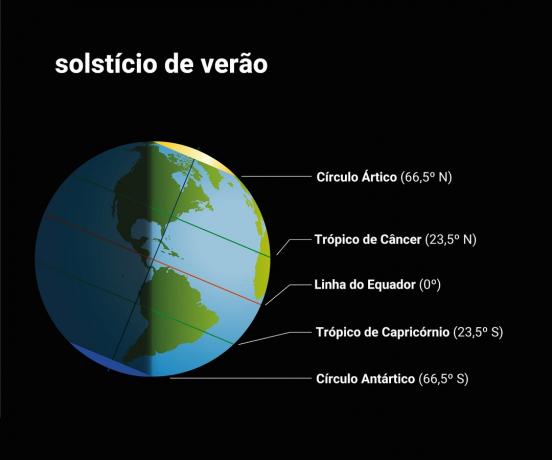Northern lights is a visual phenomenon that occurs in the northern polar regions of planet Earth, as well as others such as Jupiter, Saturn, Venus and Mars. The aurora borealis can be seen with the naked eye at night or in the late afternoon, and consists of bright colored lights, usually reddish and greenish.

The aurora borealis occurs due to the contact of particles released by solar winds with the earth's magnetic field. This phenomenon is seen in the form of homogeneous arcs close to the horizon, irregular bands that come together to form mobile auroras in the form of a curtain. They are similar to clouds with blurred borders.
There is also formation of a bright boreal corona, formed at the magnetic zenith, where all rays and diffused light seem to converge. The luminous intensity of auroras is very variable, irregular and pulsating. The color is often greenish because it corresponds to the oxygen spectrum.
Learn more about the meaning of Zenith.
The height of the aurora borealis ranges between 100 and 120 km, although in regions still lit by the sun they may appear below 80 km or above 1000 km.
The aurora borealis usually occurs in the months of September to October, and March to April, times of greater sunspot activity. This phenomenon can be reproduced artificially, for example, through nuclear explosions or in a laboratory.
Northern lights was a name created by the scientist Galileo Galilei, in the year 1619, in reference to the Roman goddess of dawn, called Aurora, and her son, called Boreas, known to be the god who rules the winds of the north.
On our planet it is possible to see these phenomena in Norway, Sweden, Finland, Iceland, Alaska, Canada, Greenland, Scotland, Russia, Faroe Islands etc.
Northern Lights and Southern Aurora
The aurora borealis is a phenomenon that occurs exclusively in the northern hemisphere. In the southern hemisphere, the aurora is known as the aurora australis. This expression was designated by the English navigator James Cook.
Thus, the main difference between both auroras is the fact that the boreal occurs at the north pole, while the austral at the south pole.
The aurora australis can be observed mainly in New Zealand, Ushuaia (Argentina), and Antarctica.
See also the meaning of Aurora and Sun.


